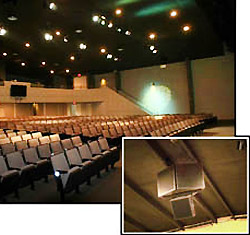The decision on the location of your sanctuary main and monitor loudspeakers will have a decided impact on the success of your presentation.
In a perfect world, as it relates to audio systems for worship, it’s best practice to place the sanctuary main loudspeakers in a central cluster above the front edge of the chancel riser.
The loudspeaker (or loudspeakers) are selected to provide pattern coverage over the entire seating area without putting acoustic energy on the walls, floor or ceiling.
When we put sound on people, it is largely absorbed and only minimal reflections continue elsewhere in their journey about the room. But when the pattern coverage is poorly designed, putting acoustic energy on highly reflective surfaces such as walls, floors and ceilings, the reflected sound can pass the listener’s ears several times, creating a lack of enunciation and speech intelligibility.
A properly designed central cluster allows the sound to reach the listener only once, thereby creating the most concise possible listening situation. In many sanctuaries, however, there are physical limitations such as low ceilings or tall crosses that require an alternate consideration.
What if we can’t use a central cluster?
When forced to consider an alternate placement, the choice is usually left side and right side. It’s important to remember that sound will arrive at two different time intervals to people seated along the sides, and so we must attempt to select loudspeakers with a narrower coverage pattern.
The goal is to put sound on people at the left with the left loudspeaker(s), and on people at the right with the right loudspeaker(s), with as little acoustic energy crossing over the middle as possible.
How high should the loudspeakers be hung/flown?
Generally speaking, loudspeakers should be flown as high as possible (however, generally not to exceed 18-22 feet) in order to increase their distance from the front pew.
If the room has extremely low ceilings, we can arrive at a condition where people seated at the front are complaining that it is too loud, while the people at the rear are commenting that the sound needs to be turned up. In such an instance, it’s advisable to turn the system down to a comfortable level and hang a second and even third set of loudspeakers perhaps every 25-30 feet as we grow in distance from the chancel.
Because sound traveling through the air takes time, the second set of loudspeakers will need to utilize a time delay so that the sound traveling from the chancel coincides perfectly with the sound emanating from the second set of loudspeakers. A third set of loudspeakers will have to be delayed at yet a different setting to coincide with the sound emanating from the first two sets of loudspeakers.
In this manner, all sound source material reaches the ears of the listener at the exact same moment in time, regardless of how far back they are seated in the room, thereby maintaining speech intelligibility.




















